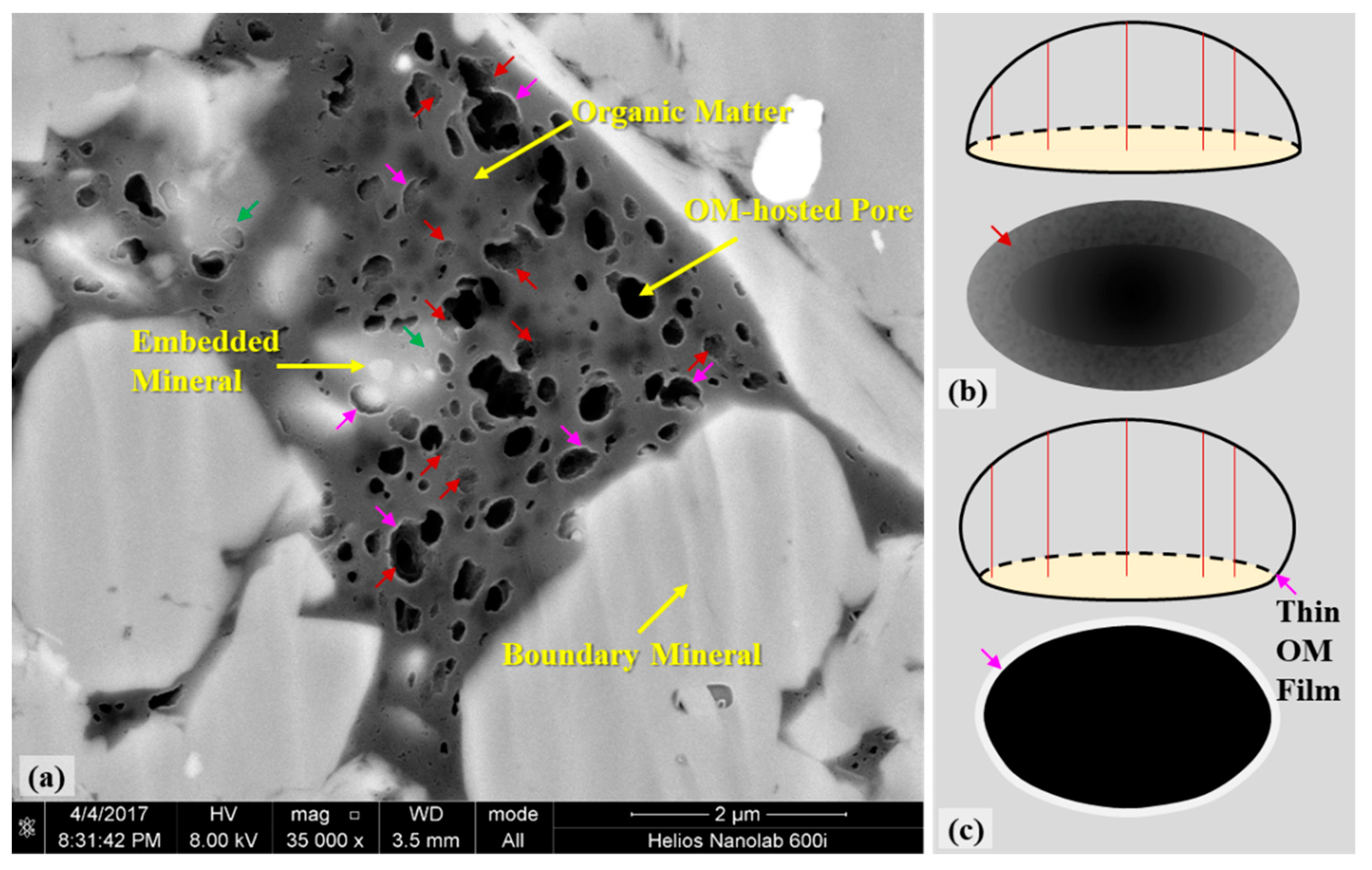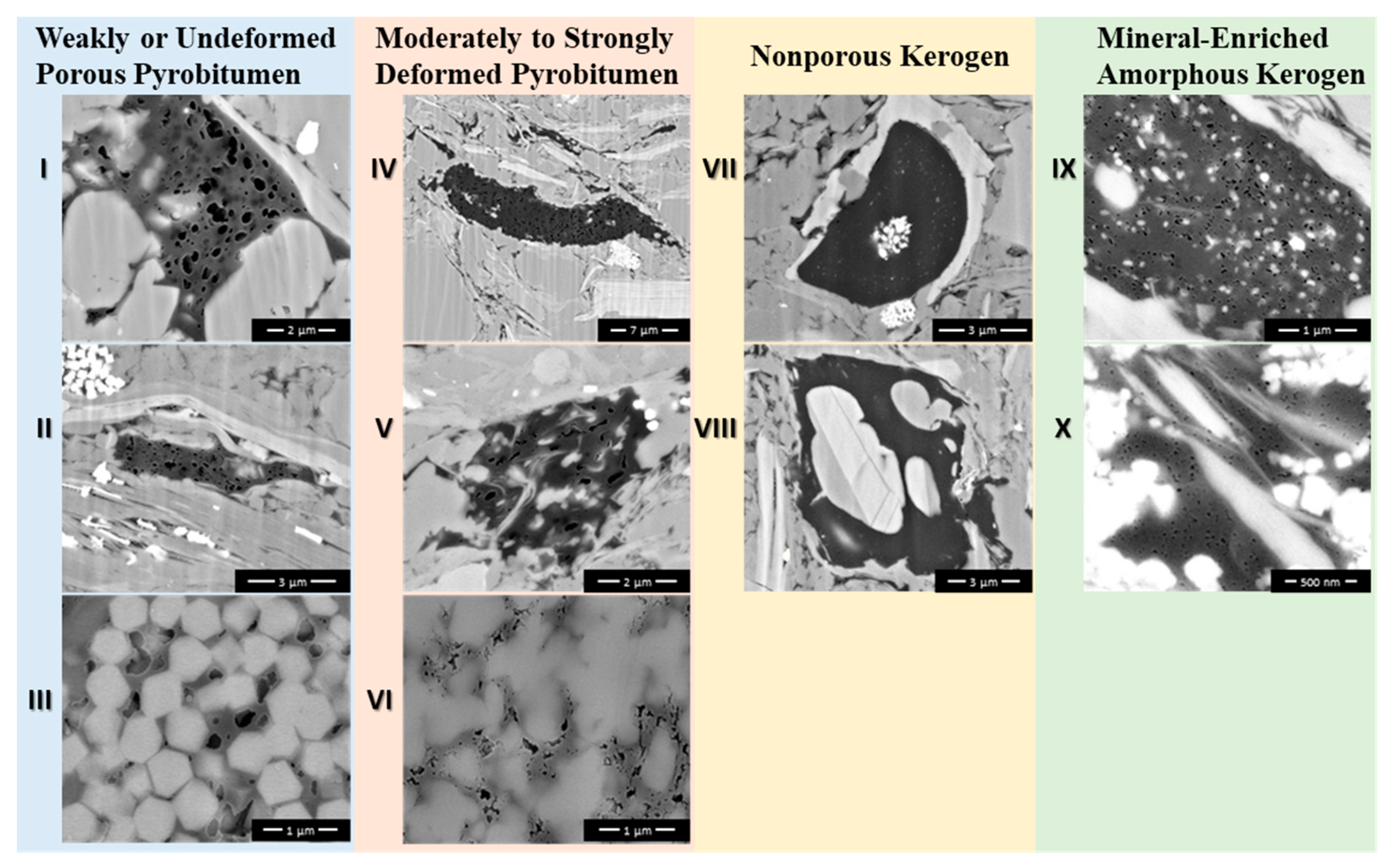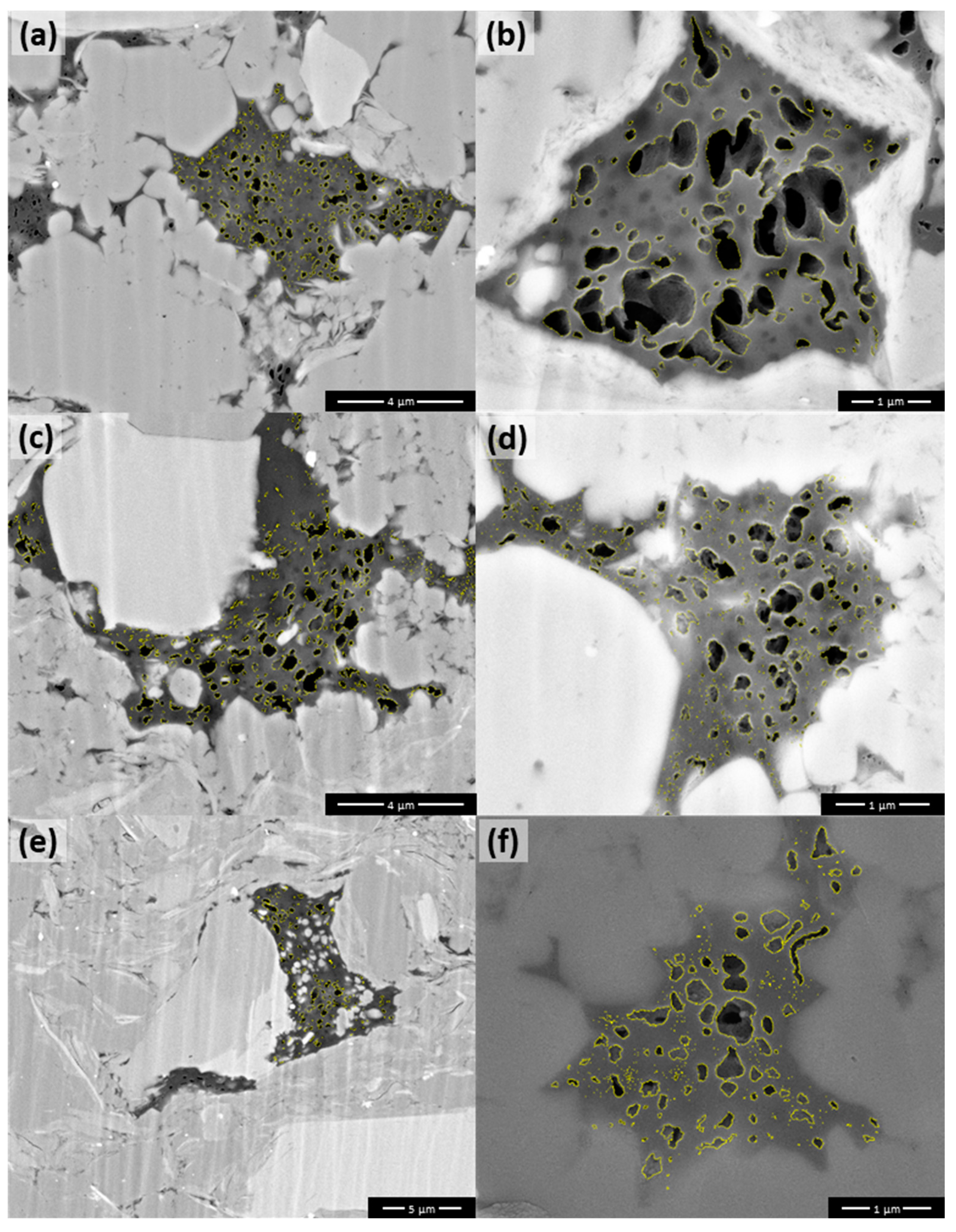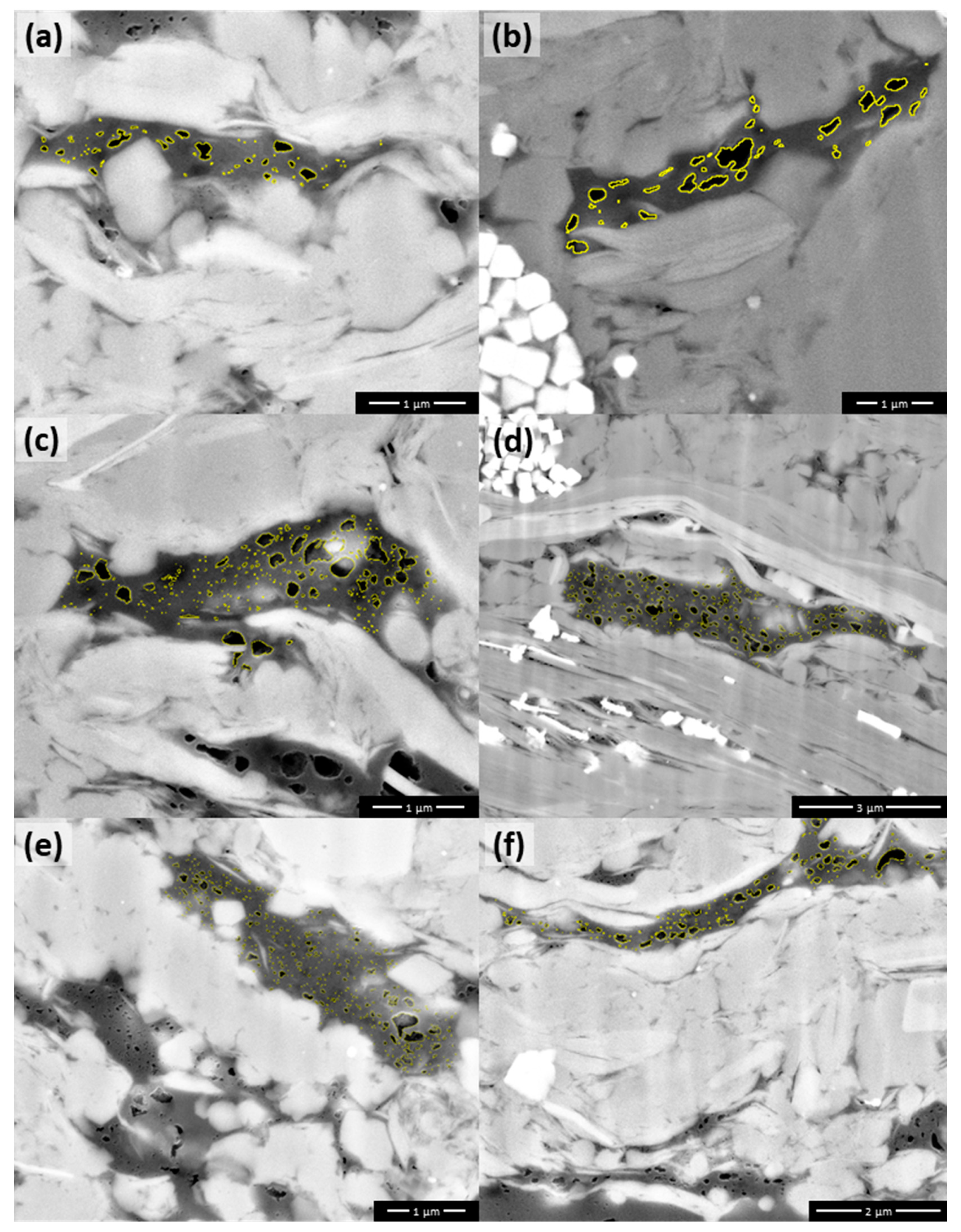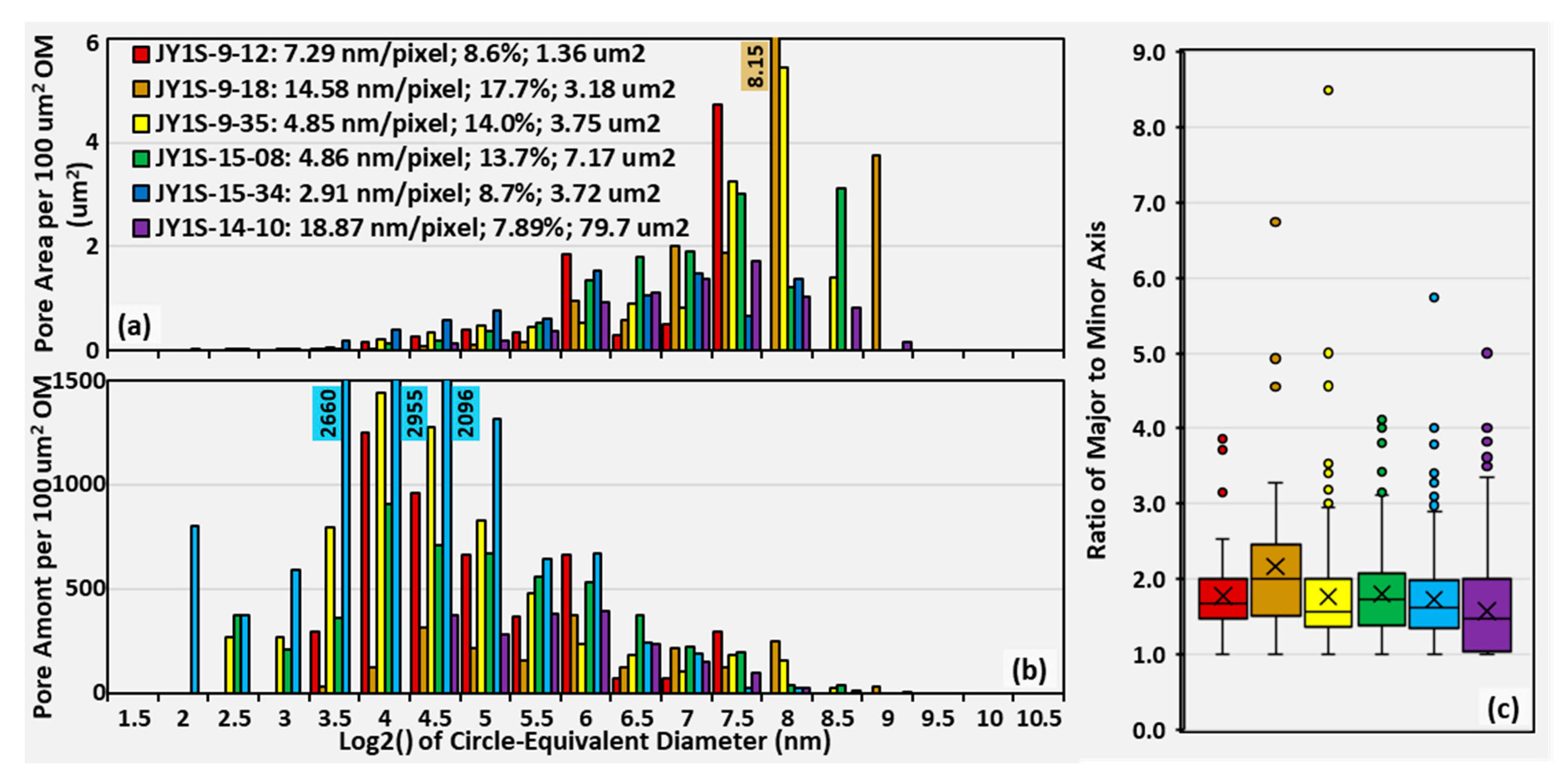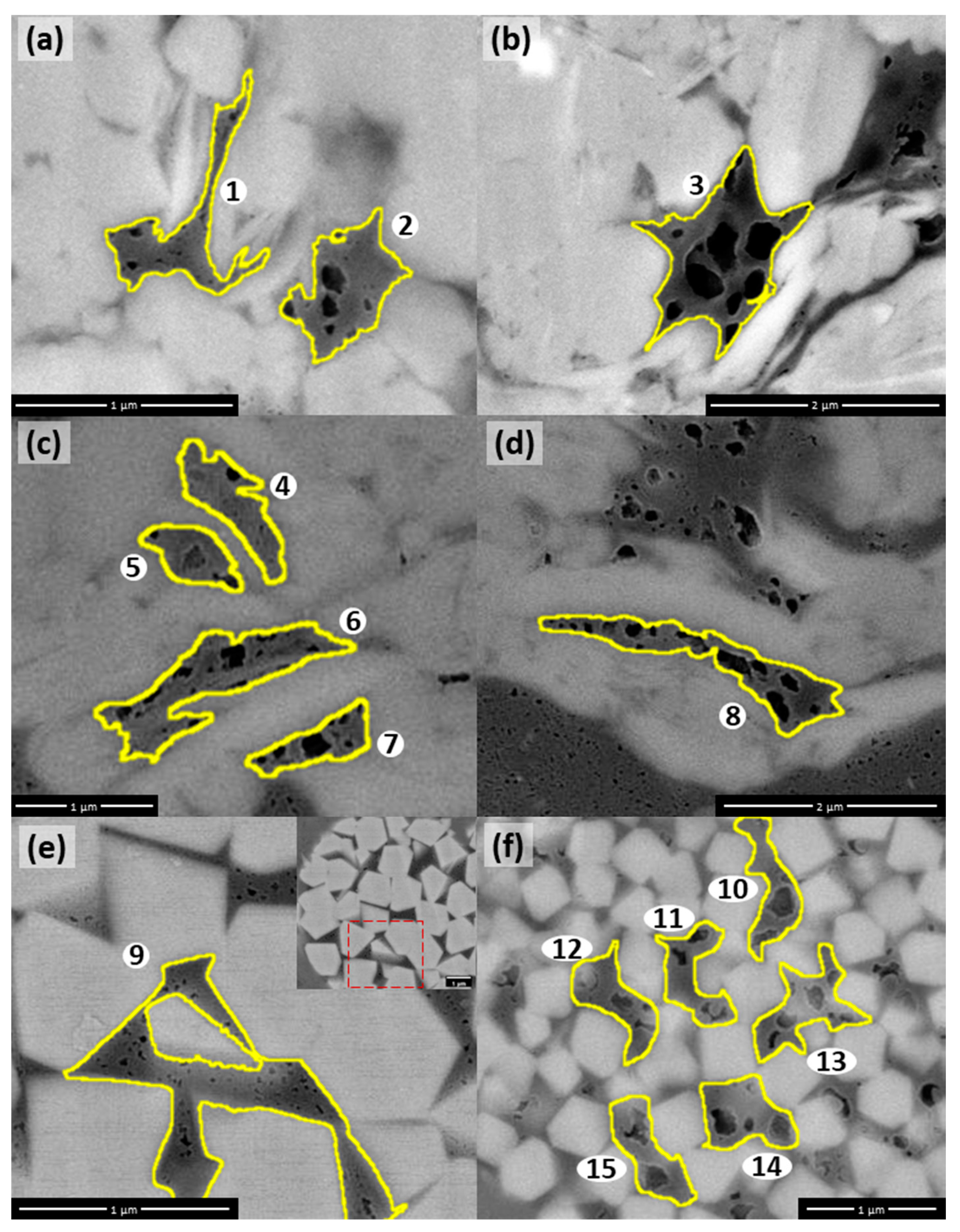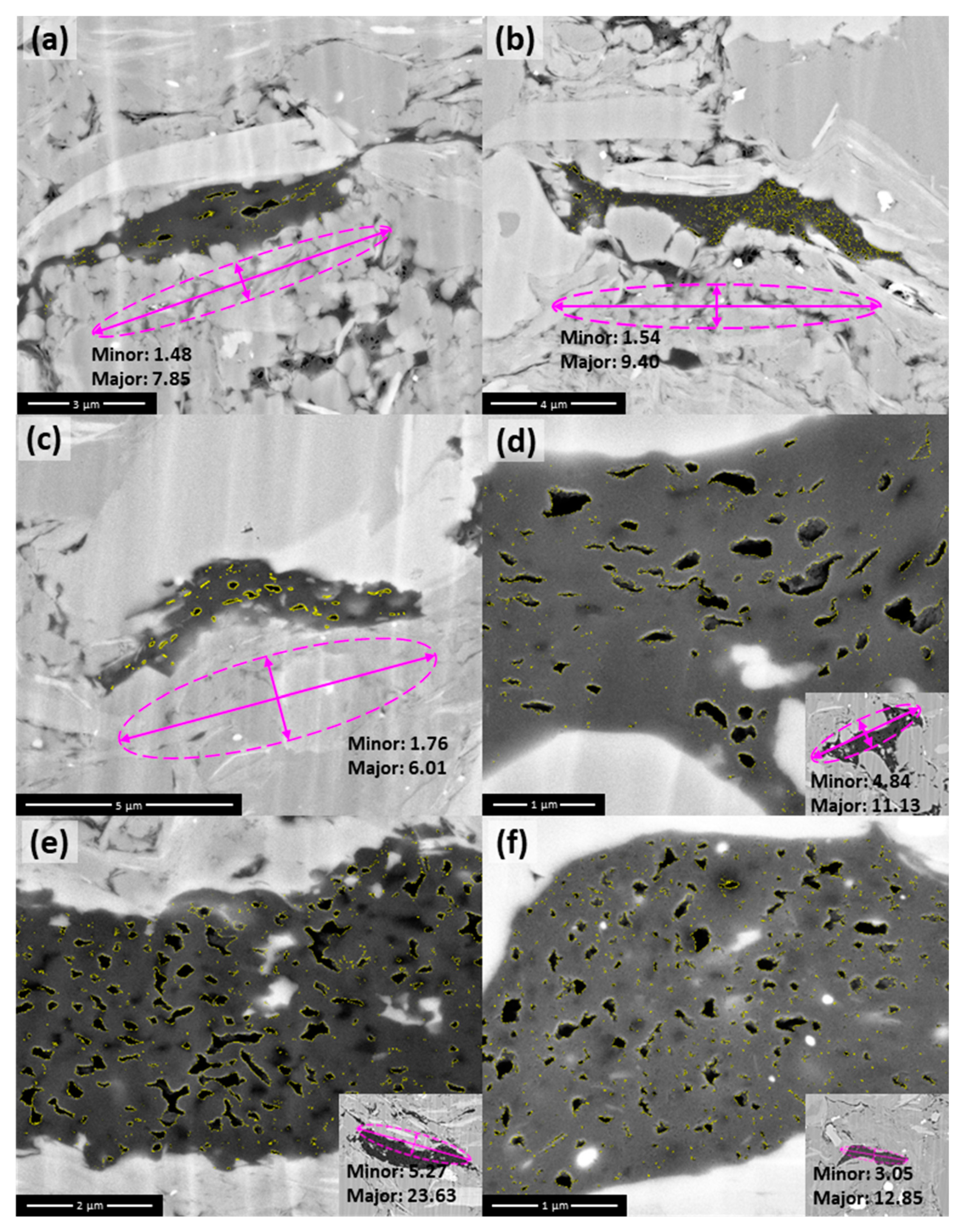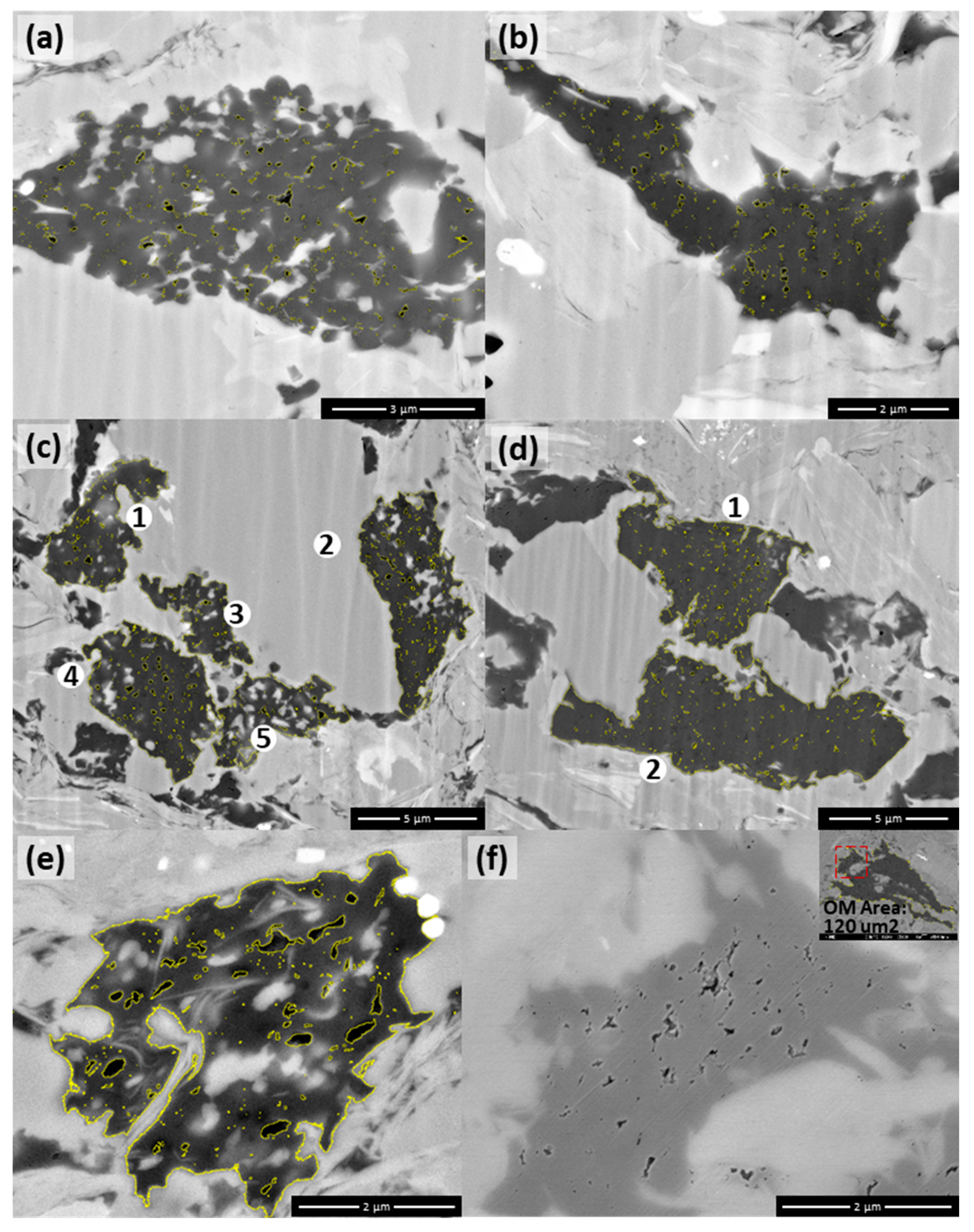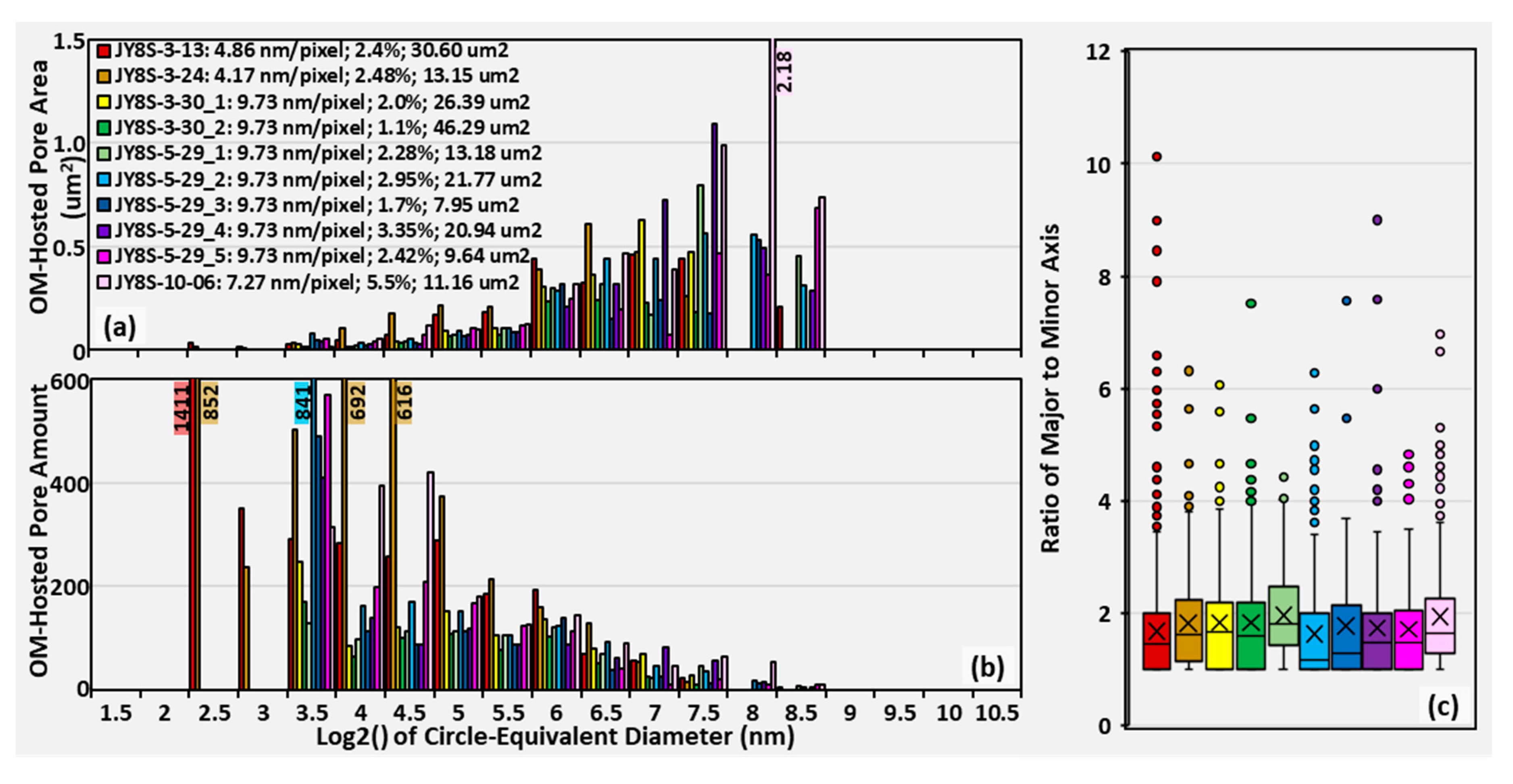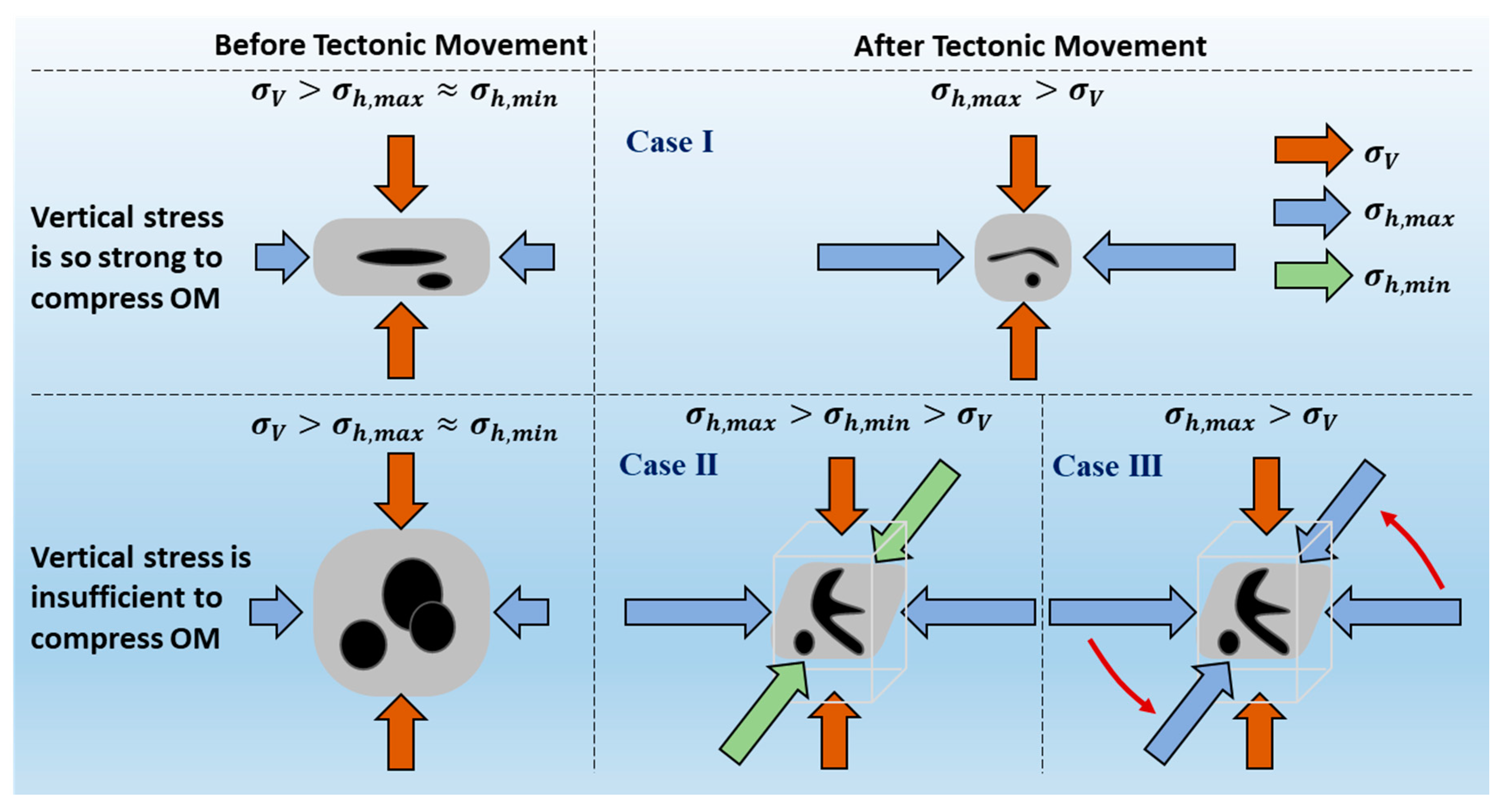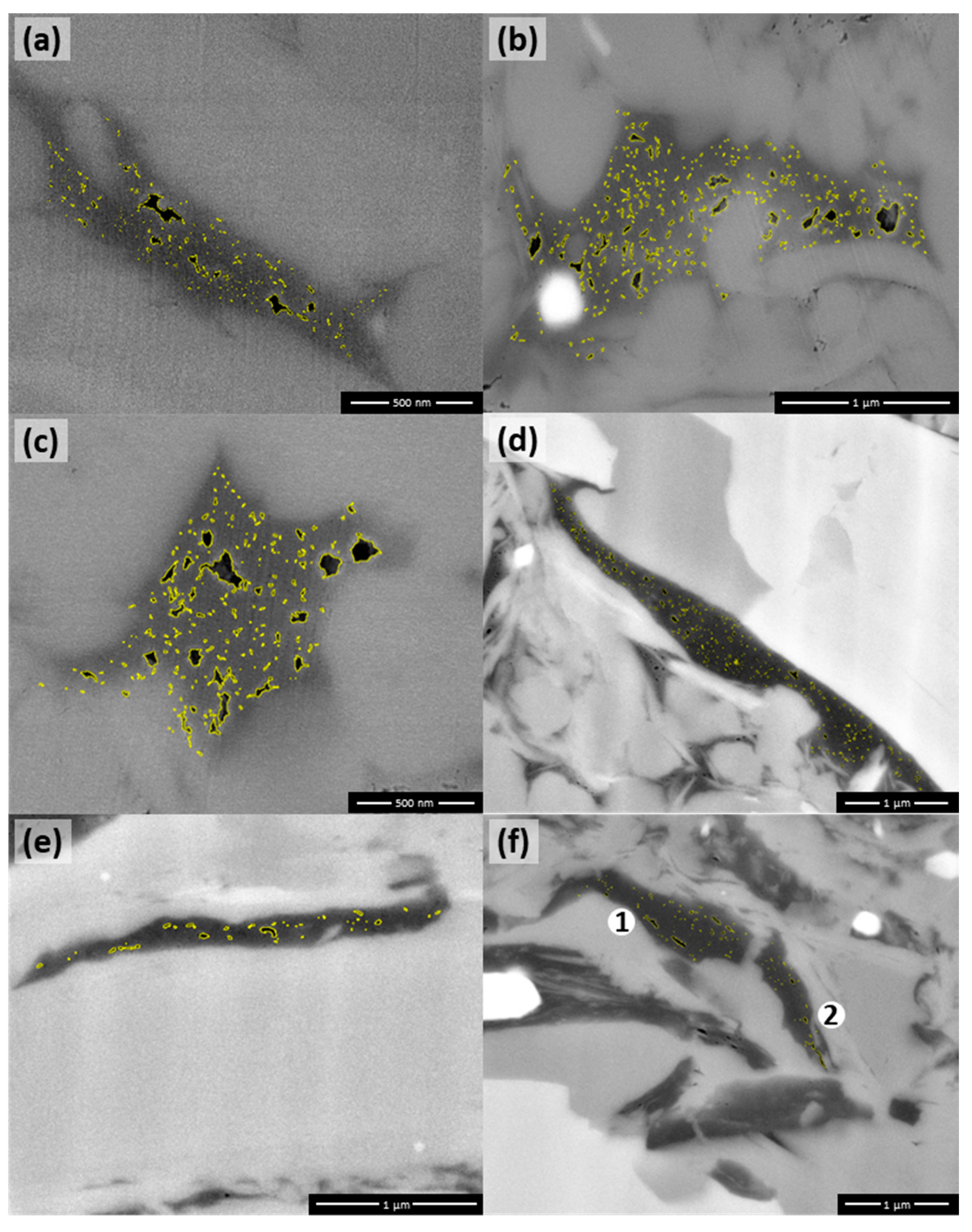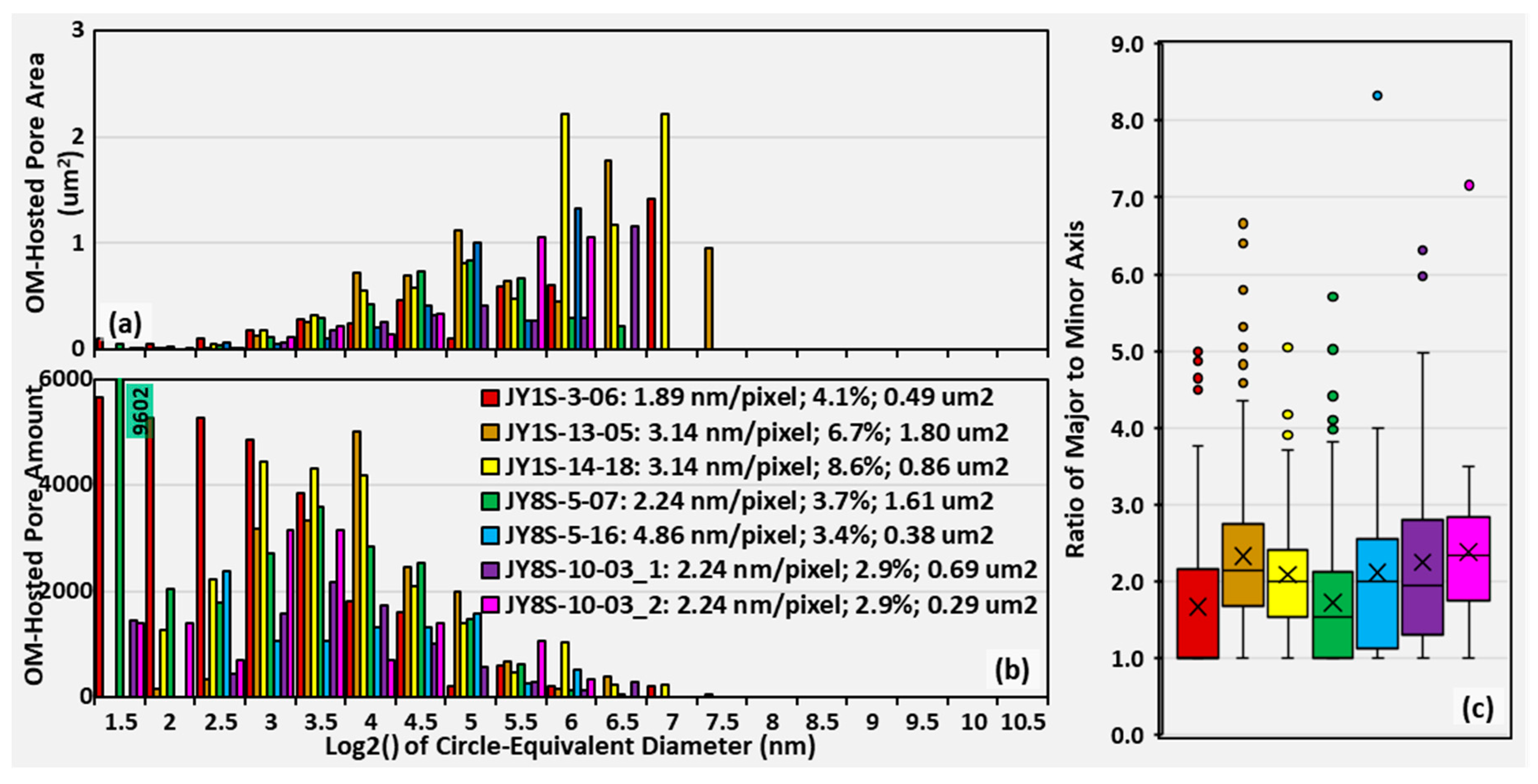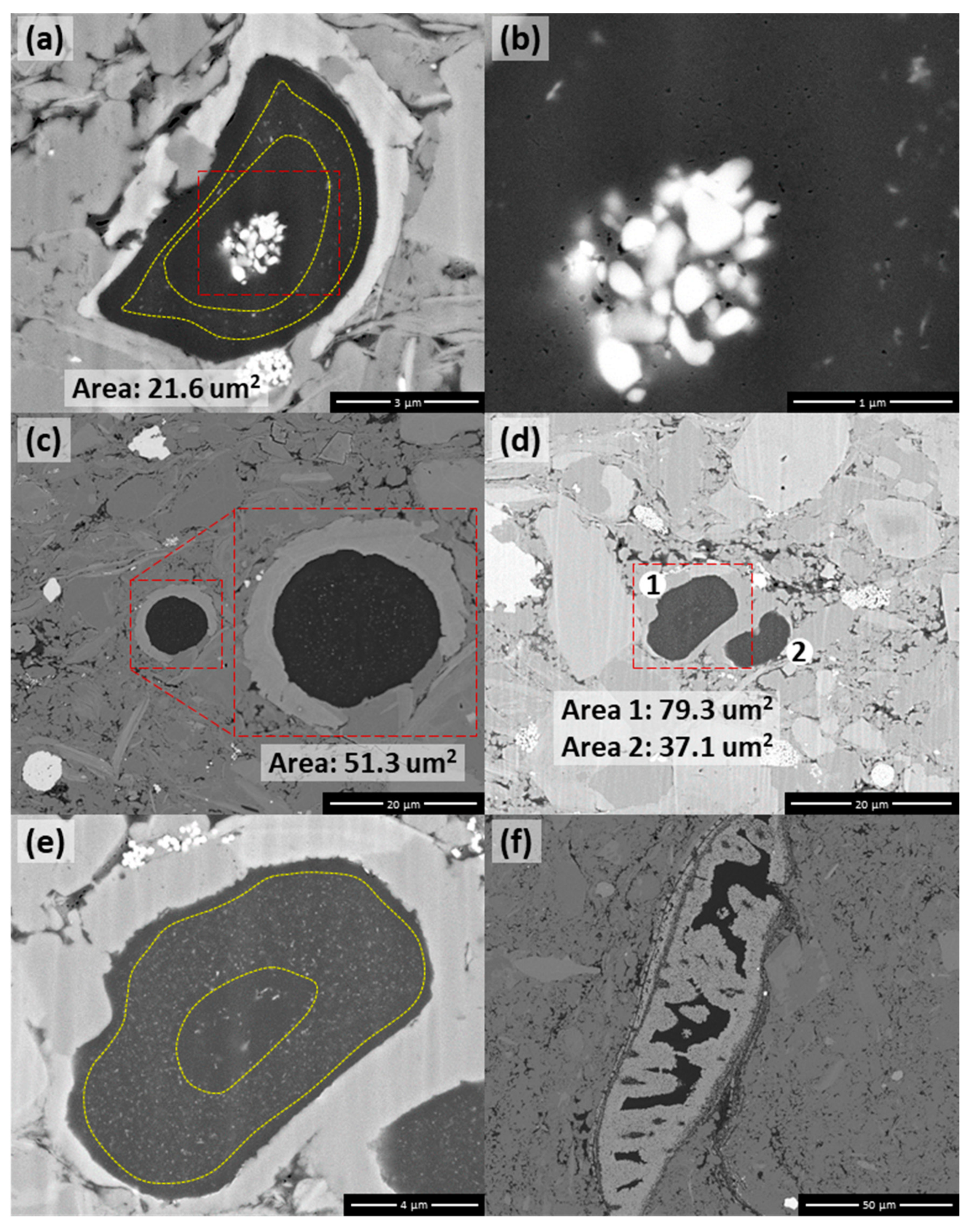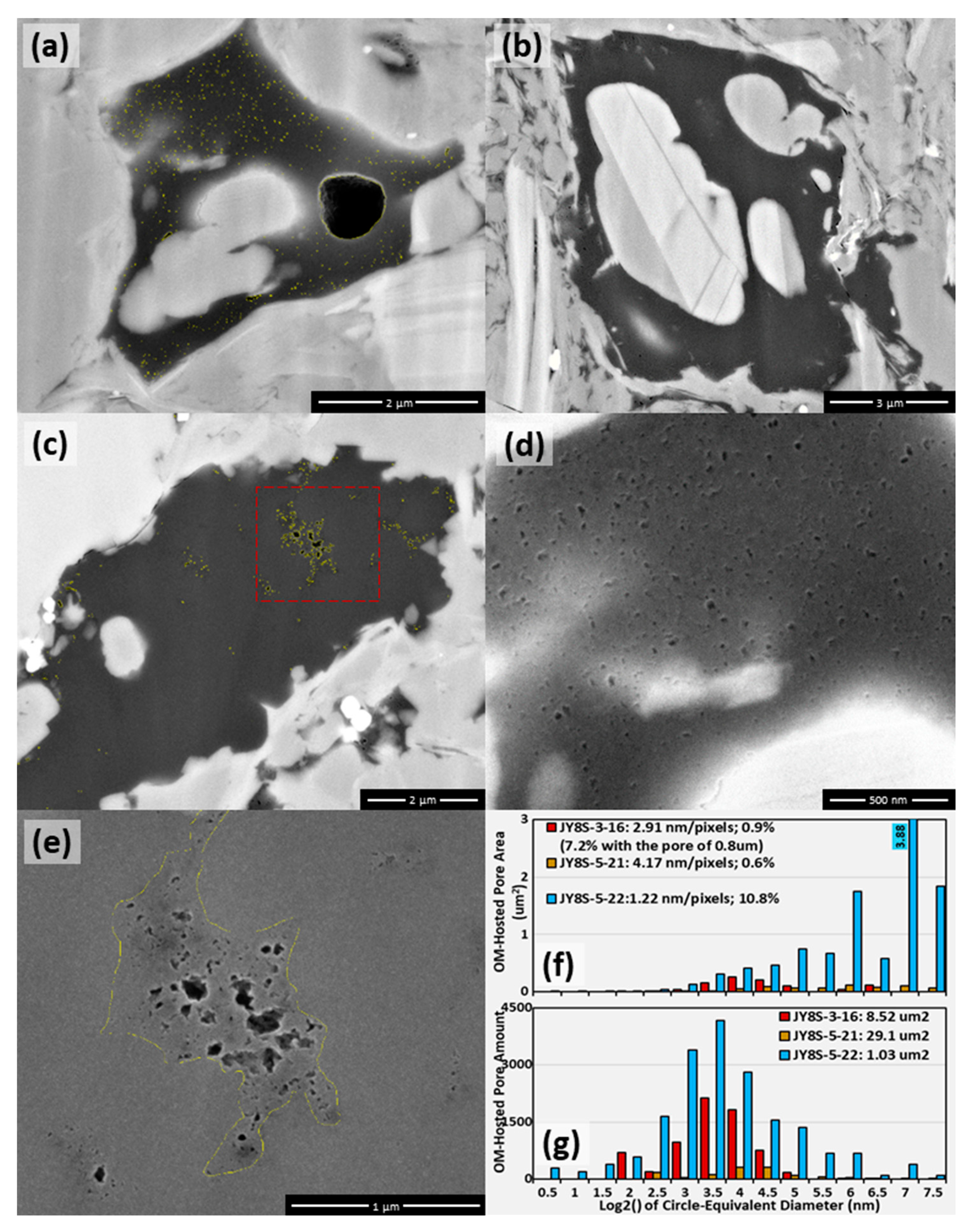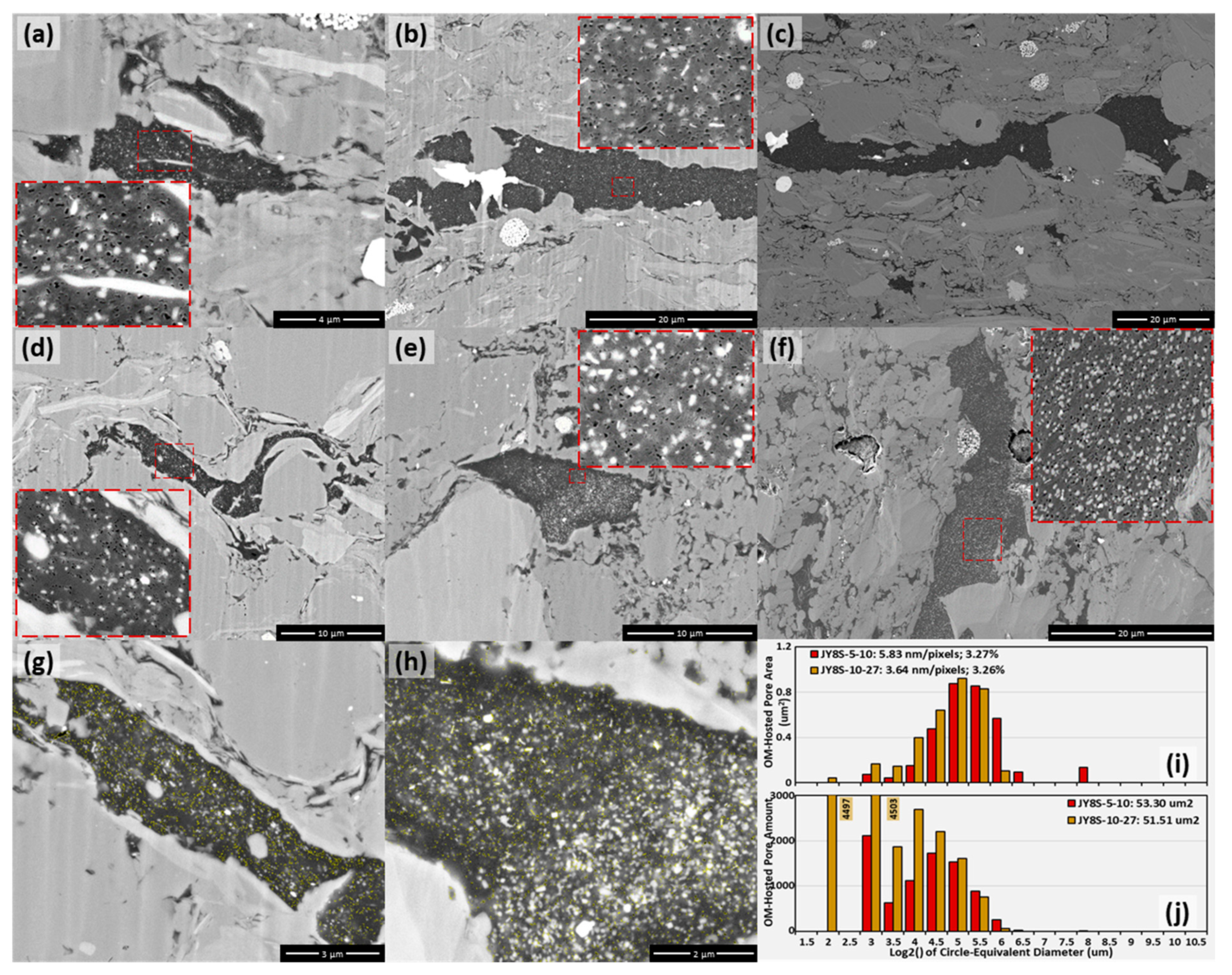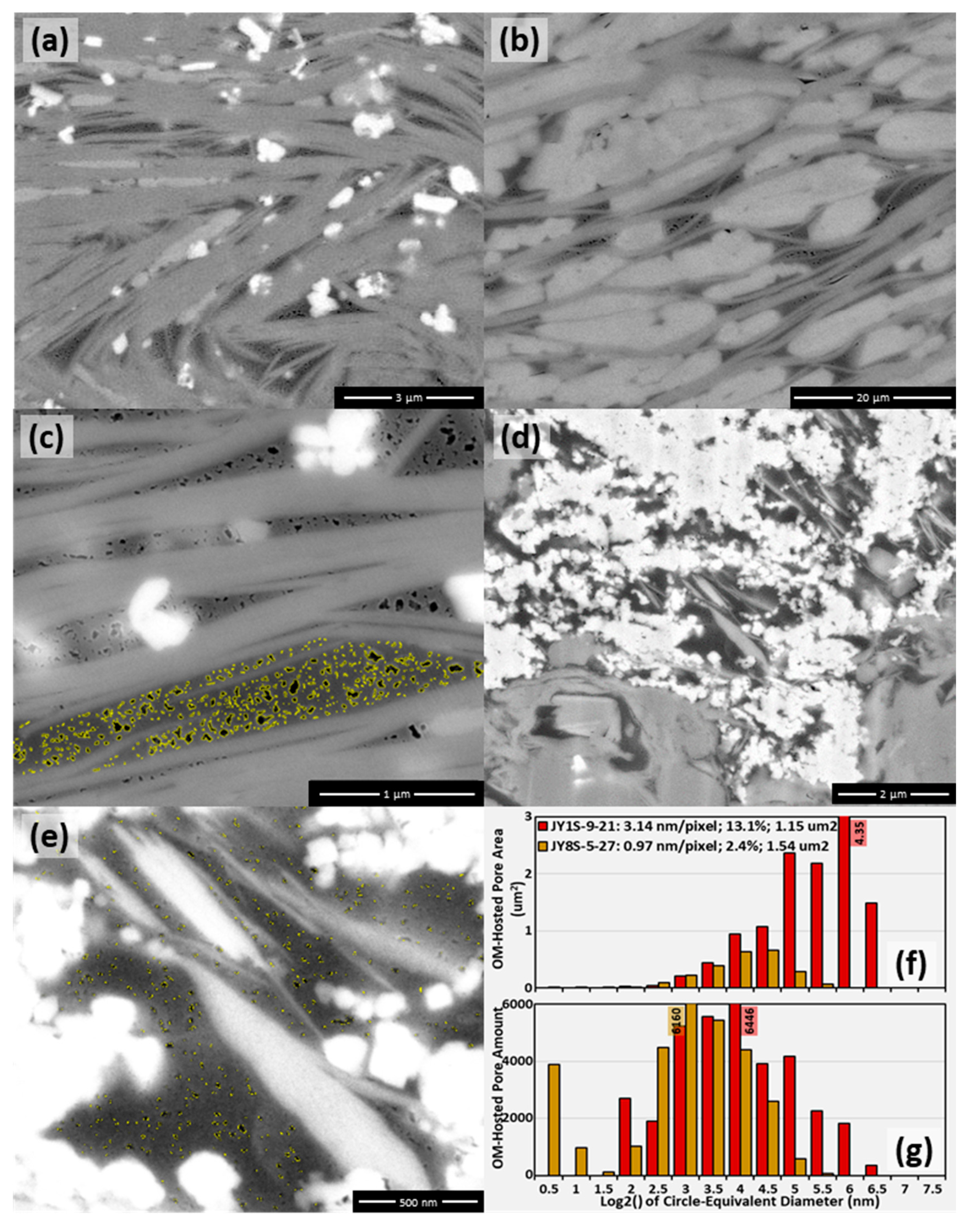Figure 1.
The structural features of the eastern Sichuan Basin (
a) and the stratigraphy of wells JY1 and JY8 with organic matter richness and porosity (
b). The structural feature was modified by Zhigang Wang [
26] and the stratigraphic column was modified from [
27].
Figure 1.
The structural features of the eastern Sichuan Basin (
a) and the stratigraphy of wells JY1 and JY8 with organic matter richness and porosity (
b). The structural feature was modified by Zhigang Wang [
26] and the stratigraphic column was modified from [
27].
Figure 2.
Example of organic matter, OM-hosted pores, minerals of Longamxi Shale, Sichuan Basin (a) and an illustration of intersection of OM-hosted pores and SEM section for roughness texture (b) and white edge (c). The SEM image is from core sample JY1S-4, the red arrow points to the roughness texture, the purple arrow points to the white edge, and the green arrow points to the region with the lower gray level of OM and OM-hosted pores.
Figure 2.
Example of organic matter, OM-hosted pores, minerals of Longamxi Shale, Sichuan Basin (a) and an illustration of intersection of OM-hosted pores and SEM section for roughness texture (b) and white edge (c). The SEM image is from core sample JY1S-4, the red arrow points to the roughness texture, the purple arrow points to the white edge, and the green arrow points to the region with the lower gray level of OM and OM-hosted pores.
Figure 3.
Classification of organic matter particles with high to over mature Longmaxi-Wufeng Shale, Eastern Sichuan Basin. Sample ID of images of I to X is JY1S-9, JY1S-15, JY1S-13, JY8S-5, JY8S-10, JY1S-15, JY1S-9, JY8S-5, JY8S-5, and JY8S-5.
Figure 3.
Classification of organic matter particles with high to over mature Longmaxi-Wufeng Shale, Eastern Sichuan Basin. Sample ID of images of I to X is JY1S-9, JY1S-15, JY1S-13, JY8S-5, JY8S-10, JY1S-15, JY1S-9, JY8S-5, JY8S-5, and JY8S-5.
Figure 4.
The typical examples of the first subtype of weakly or undeformed porous pyrobitumen (OM I) from Longmaxi-Wufeng Shale, Sichuan Basin. (a) SEM image JY1S-9-02 (well ID-sample no.-image no.); (b) SEM image JY1S-9-17; (c) SEM image JY1S-9-22; (d) SEM image JY1S-15-23; (e) SEM image JY8S-3-35; and (f) SEM image JY1S-12-12. The boundary of OM-hosted pores is outlined in yellow.
Figure 4.
The typical examples of the first subtype of weakly or undeformed porous pyrobitumen (OM I) from Longmaxi-Wufeng Shale, Sichuan Basin. (a) SEM image JY1S-9-02 (well ID-sample no.-image no.); (b) SEM image JY1S-9-17; (c) SEM image JY1S-9-22; (d) SEM image JY1S-15-23; (e) SEM image JY8S-3-35; and (f) SEM image JY1S-12-12. The boundary of OM-hosted pores is outlined in yellow.
Figure 5.
The pore size distribution (PSD) and geometry of OM-hosted pores within the first subtype of weakly or undeformed porous pyrobitumen (OM I) of Longmaxi-Wufeng Shale, eastern Sichuan Basin. (a) PSD determined by pore sectional area; (b) PSD determined by pore amount; and (c) ratio of major to minor axis. The three values after image ID in the legend are image resolution (nm/pixel), organic porosity (%), and OM sectional area (µm2). The number labels show the values that are beyond the range of the vertical axis.
Figure 5.
The pore size distribution (PSD) and geometry of OM-hosted pores within the first subtype of weakly or undeformed porous pyrobitumen (OM I) of Longmaxi-Wufeng Shale, eastern Sichuan Basin. (a) PSD determined by pore sectional area; (b) PSD determined by pore amount; and (c) ratio of major to minor axis. The three values after image ID in the legend are image resolution (nm/pixel), organic porosity (%), and OM sectional area (µm2). The number labels show the values that are beyond the range of the vertical axis.
Figure 6.
The typical examples of the second subtype of weakly or undeformed porous pyrobitumen (OM II) from Longmaxi-Wufeng Shale, Sichuan Basin. (a) SEM image JY1S-9-12 (well ID-sample no.-image no.); (b) SEM image JY1S-9-18; (c) SEM image JY1S-9-35; (d) SEM image JY1S-15-08; (e) SEM image JY8S-3-34; and (f) SEM image JY1S-14-10. The boundary of OM-hosted pores is outlined in yellow.
Figure 6.
The typical examples of the second subtype of weakly or undeformed porous pyrobitumen (OM II) from Longmaxi-Wufeng Shale, Sichuan Basin. (a) SEM image JY1S-9-12 (well ID-sample no.-image no.); (b) SEM image JY1S-9-18; (c) SEM image JY1S-9-35; (d) SEM image JY1S-15-08; (e) SEM image JY8S-3-34; and (f) SEM image JY1S-14-10. The boundary of OM-hosted pores is outlined in yellow.
Figure 7.
The pore size distribution (PSD) and geometry of OM-hosted pores within the second subtype of weakly or undeformed porous pyrobitumen (OM II) of Longmaxi-Wufeng Shale, Eastern Sichuan Basin. (a) PSD determined by pore sectional area; (b) PSD determined by pore amount; and (c) ratio of the major to minor axis. The three values after image ID in the legend are image resolution (nm/pixel), organic porosity (%), and OM sectional area (µm2). The number labels show the values that are beyond the range of the vertical axis.
Figure 7.
The pore size distribution (PSD) and geometry of OM-hosted pores within the second subtype of weakly or undeformed porous pyrobitumen (OM II) of Longmaxi-Wufeng Shale, Eastern Sichuan Basin. (a) PSD determined by pore sectional area; (b) PSD determined by pore amount; and (c) ratio of the major to minor axis. The three values after image ID in the legend are image resolution (nm/pixel), organic porosity (%), and OM sectional area (µm2). The number labels show the values that are beyond the range of the vertical axis.
Figure 8.
Typical examples of the third subtype of weakly or un-deformed porous pyrobitumen (OM III) and the statistical analysis of OM-hosted pores of Longmaxi-Wufeng Shale, Sichuan Basin. (a) SEM image JY1S-9-25 (well ID-sample no.-image no.); (b) SEM image JY1S-9-39; (c) SEM image JY1S-9-10; (d) SEM image JY1S-9-10; (e) SEM image JY1S-4-13; (f) SEM image JY1S-10-1. The yellow lines indicate the boundary of organic matter particles.
Figure 8.
Typical examples of the third subtype of weakly or un-deformed porous pyrobitumen (OM III) and the statistical analysis of OM-hosted pores of Longmaxi-Wufeng Shale, Sichuan Basin. (a) SEM image JY1S-9-25 (well ID-sample no.-image no.); (b) SEM image JY1S-9-39; (c) SEM image JY1S-9-10; (d) SEM image JY1S-9-10; (e) SEM image JY1S-4-13; (f) SEM image JY1S-10-1. The yellow lines indicate the boundary of organic matter particles.
Figure 9.
Statistical analysis of the 15 particles of OM III shown in
Figure 8. (
a) histogram of sectional area of the 15 particles of OM III; (
b) histogram of organic porosity of the 15 particles of OM III; (
c) pore size distribution determined by pore sectional area of all OM-hosted pores within the 15 OM III together; and (
d) pore size distribution determined by pore amount of all OM-hosted pores within the 15 OM III together.
Figure 9.
Statistical analysis of the 15 particles of OM III shown in
Figure 8. (
a) histogram of sectional area of the 15 particles of OM III; (
b) histogram of organic porosity of the 15 particles of OM III; (
c) pore size distribution determined by pore sectional area of all OM-hosted pores within the 15 OM III together; and (
d) pore size distribution determined by pore amount of all OM-hosted pores within the 15 OM III together.
Figure 10.
The typical examples of the first subtype of moderately to strongly deformed pyrobitumen (OM IV) from Longmaxi-Wufeng Shale, Sichuan Basin. (a) SEM image JY1S-9-25 (well ID-sample no.-image no.); (b) SEM image JY1S-15-31; (c) SEM image JY8S-3-35; (d) SEM image JY8S-5-20; (e) SEM image JY8S-5-39; (f) SEM image JY8S-5-17. The boundary of OM-hosted pores was outlined by yellow lines; the purple ellipse is the area-equivalent ellipse of OM; the unit of major and minor axis is µm.
Figure 10.
The typical examples of the first subtype of moderately to strongly deformed pyrobitumen (OM IV) from Longmaxi-Wufeng Shale, Sichuan Basin. (a) SEM image JY1S-9-25 (well ID-sample no.-image no.); (b) SEM image JY1S-15-31; (c) SEM image JY8S-3-35; (d) SEM image JY8S-5-20; (e) SEM image JY8S-5-39; (f) SEM image JY8S-5-17. The boundary of OM-hosted pores was outlined by yellow lines; the purple ellipse is the area-equivalent ellipse of OM; the unit of major and minor axis is µm.
Figure 11.
The pore size distribution (PSD) and geometry of OM-hosted pores within the second subtype of weakly or undeformed porous pyrobitumen (OM IV) of Longmaxi-Wufeng Shale, Eastern Sichuan Basin. (a) PSD determined by pore sectional area; (b) PSD determined by pore amount; and (c) the ratio of the major to the minor axis. The three values after image ID in the legend are the image resolution (nm/pixel), organic porosity (%), and OM sectional area (µm2). The number labels show the values that are beyond the range of the vertical axis.
Figure 11.
The pore size distribution (PSD) and geometry of OM-hosted pores within the second subtype of weakly or undeformed porous pyrobitumen (OM IV) of Longmaxi-Wufeng Shale, Eastern Sichuan Basin. (a) PSD determined by pore sectional area; (b) PSD determined by pore amount; and (c) the ratio of the major to the minor axis. The three values after image ID in the legend are the image resolution (nm/pixel), organic porosity (%), and OM sectional area (µm2). The number labels show the values that are beyond the range of the vertical axis.
Figure 12.
The typical examples of the second subtype of moderately to strongly deformed pyrobitumen (OM V) from Longmaxi-Wufeng Shale, Sichuan Basin. (a) SEM image JY8S-3-13 (well ID-sample no.-image no.); (b) SEM image JY8S-3-24; (c) SEM image JY8S-3-30; (d) SEM image JY8S-5-29; (e) SEM image JY8S-10-06; and (f) SEM image JY1S-4-08. The boundary of OM-hosted pores was outlined by yellow color.
Figure 12.
The typical examples of the second subtype of moderately to strongly deformed pyrobitumen (OM V) from Longmaxi-Wufeng Shale, Sichuan Basin. (a) SEM image JY8S-3-13 (well ID-sample no.-image no.); (b) SEM image JY8S-3-24; (c) SEM image JY8S-3-30; (d) SEM image JY8S-5-29; (e) SEM image JY8S-10-06; and (f) SEM image JY1S-4-08. The boundary of OM-hosted pores was outlined by yellow color.
Figure 13.
The pore size distribution (PSD) and geometry of OM-hosted pores within the second subtype of weakly or undeformed porous pyrobitumen (OM V) of Longmaxi-Wufeng Shale, Eastern Sichuan Basin. (a) PSD determined by pore sectional area; (b) PSD determined by pore amount; and (c) ratio of major to minor axis. The three values after image ID in the legend are image resolution (nm/pixel), organic porosity (%), and OM sectional area (µm2). The number labels show the values that are beyond the range of the vertical axis.
Figure 13.
The pore size distribution (PSD) and geometry of OM-hosted pores within the second subtype of weakly or undeformed porous pyrobitumen (OM V) of Longmaxi-Wufeng Shale, Eastern Sichuan Basin. (a) PSD determined by pore sectional area; (b) PSD determined by pore amount; and (c) ratio of major to minor axis. The three values after image ID in the legend are image resolution (nm/pixel), organic porosity (%), and OM sectional area (µm2). The number labels show the values that are beyond the range of the vertical axis.
Figure 14.
The generalized deformation process and the associated stress condition of OM V during tectonic movement. The orange arrow indicates rotation of the improved horizontal principle stress due to tectonic movements.
Figure 14.
The generalized deformation process and the associated stress condition of OM V during tectonic movement. The orange arrow indicates rotation of the improved horizontal principle stress due to tectonic movements.
Figure 15.
Examples of the third subtype of moderately to strongly deformed pyrobitumen (OM VI) from Longmaxi-Wufeng Shale, Sichuan Basin. (a) SEM image JY1S-3-6 (well ID-sample no.-image no.); (b) SEM image JY1S-13-05; (c) SEM image JY1S-14-18; (d) SEM image JY8S-5-07; (e) SEM image JY8S-5-16; and (f) SEM image JY8S-10-03. The boundary of OM-hosted pores was outlined by yellow color.
Figure 15.
Examples of the third subtype of moderately to strongly deformed pyrobitumen (OM VI) from Longmaxi-Wufeng Shale, Sichuan Basin. (a) SEM image JY1S-3-6 (well ID-sample no.-image no.); (b) SEM image JY1S-13-05; (c) SEM image JY1S-14-18; (d) SEM image JY8S-5-07; (e) SEM image JY8S-5-16; and (f) SEM image JY8S-10-03. The boundary of OM-hosted pores was outlined by yellow color.
Figure 16.
The pore size distribution (PSD) and geometry of OM-hosted pores within the third subtype of weakly or undeformed porous pyrobitumen (OM VI) of Longmaxi-Wufeng Shale, Eastern Sichuan Basin. (a) PSD determined by pore sectional area; and (b) PSD determined by pore amount; and (c) ratio of major to minor axis. The three values after image ID in the legend are image resolution (nm/pixel), organic porosity (%), and OM sectional area (µm2). The number labels show the values that are beyond the range of the vertical axis.
Figure 16.
The pore size distribution (PSD) and geometry of OM-hosted pores within the third subtype of weakly or undeformed porous pyrobitumen (OM VI) of Longmaxi-Wufeng Shale, Eastern Sichuan Basin. (a) PSD determined by pore sectional area; and (b) PSD determined by pore amount; and (c) ratio of major to minor axis. The three values after image ID in the legend are image resolution (nm/pixel), organic porosity (%), and OM sectional area (µm2). The number labels show the values that are beyond the range of the vertical axis.
Figure 17.
Examples of the nonporous kerogen bounded by biogenic minerals (OM VII) from Longmaxi-Wufeng Shale, Sichuan Basin. (a) SEM image JY1S-9-06 (well ID-sample no.-image no.); (b) SEM image JY1S-9-07, a near view of SEM image JY1S-0-06; (c) SEM image JY1S-9-51; (d) SEM image JY1S-15-10; (e) SEM image JY1S-15-11, a near view of SEM image JY1S-15-10; (f) SEM image JY1S-27-06. The red rectangle indicates the location of the near view of SEM images; the yellow dashed curve indicates the ring belt rich of tiny small apatite.
Figure 17.
Examples of the nonporous kerogen bounded by biogenic minerals (OM VII) from Longmaxi-Wufeng Shale, Sichuan Basin. (a) SEM image JY1S-9-06 (well ID-sample no.-image no.); (b) SEM image JY1S-9-07, a near view of SEM image JY1S-0-06; (c) SEM image JY1S-9-51; (d) SEM image JY1S-15-10; (e) SEM image JY1S-15-11, a near view of SEM image JY1S-15-10; (f) SEM image JY1S-27-06. The red rectangle indicates the location of the near view of SEM images; the yellow dashed curve indicates the ring belt rich of tiny small apatite.
Figure 18.
Examples of the nonporous kerogen without bio-mineral boundaries (OM VIII) from Longmaxi-Wufeng Shale, Sichuan Basin. (a) SEM image JY8S-3-16 (well ID-sample no.-image no.); (b) SEM image JY8S-5-35; (c) SEM image JY8S-10-21; (d) SEM image JY8S-3-17, a near view of OM in SEM image JY8S-5-35; (e) SEM image JY8S-10-22, a near view of OM on SEM image JY8S-10-21; (f) pore size distribution of OM-hosted pores determined by OM-hosted pore area; (g) pore size distribution of OM-hosted pores determined by pore amount. The red rectangle indicates the location of the near view of SEM images; the yellow curve indicates the boundary of OM-hosted pores.
Figure 18.
Examples of the nonporous kerogen without bio-mineral boundaries (OM VIII) from Longmaxi-Wufeng Shale, Sichuan Basin. (a) SEM image JY8S-3-16 (well ID-sample no.-image no.); (b) SEM image JY8S-5-35; (c) SEM image JY8S-10-21; (d) SEM image JY8S-3-17, a near view of OM in SEM image JY8S-5-35; (e) SEM image JY8S-10-22, a near view of OM on SEM image JY8S-10-21; (f) pore size distribution of OM-hosted pores determined by OM-hosted pore area; (g) pore size distribution of OM-hosted pores determined by pore amount. The red rectangle indicates the location of the near view of SEM images; the yellow curve indicates the boundary of OM-hosted pores.
Figure 19.
Examples of the amorphous kerogen rich of small bright minerals (OM IX) from Longmaxi-Wufeng Shale, Sichuan Basin. (a) SEM image JY8S-3-02 (well ID-sample no.-image no.); (b) SEM image JY8S-3-39; (c) SEM image JY8S-10-21; (d) SEM image JY8S-5-09; (e) SEM image JY8S-10-26; (f) SEM image JY1S-27-1; (g) SEM image JY8S-5-10, a near view of JY8S-5-09 with pores highlighted by yellow; (h) JY8S-10-27, a near view of JY8S-10-26 with pores highlighted by yellow; (i) pore size distribution of OM-hosted pores determined by pore area; (j) pore size distribution of OM-hosted pores determined by pore amount. The red rectangle indicates the location of the near view of SEM images. Organic pores in (g) and (h) were highlighted using yellow lines.
Figure 19.
Examples of the amorphous kerogen rich of small bright minerals (OM IX) from Longmaxi-Wufeng Shale, Sichuan Basin. (a) SEM image JY8S-3-02 (well ID-sample no.-image no.); (b) SEM image JY8S-3-39; (c) SEM image JY8S-10-21; (d) SEM image JY8S-5-09; (e) SEM image JY8S-10-26; (f) SEM image JY1S-27-1; (g) SEM image JY8S-5-10, a near view of JY8S-5-09 with pores highlighted by yellow; (h) JY8S-10-27, a near view of JY8S-10-26 with pores highlighted by yellow; (i) pore size distribution of OM-hosted pores determined by pore area; (j) pore size distribution of OM-hosted pores determined by pore amount. The red rectangle indicates the location of the near view of SEM images. Organic pores in (g) and (h) were highlighted using yellow lines.
Figure 20.
Examples of the amorphous kerogen enriched with mica and/or monocyrstal clay mineral as well as bio-quartz and bright minerals (OM X) from Longmaxi-Wufeng Shale, Sichuan Basin. (a) SEM image JY1S-9-20 (well ID-sample no.-image no.); (b) SEM image JY1S-9-23; (c) SEM image JY1S-9-21 with pores highlighted by yellow; (d) SEM image JY8S-5-26; (e) SEM image JY8S-5-27 with pores highlighted by yellow; (f) pore size distribution of OM-hosted pores determined by pore area; and (g) pore size distribution of OM-hosted pores determined by pore amount.
Figure 20.
Examples of the amorphous kerogen enriched with mica and/or monocyrstal clay mineral as well as bio-quartz and bright minerals (OM X) from Longmaxi-Wufeng Shale, Sichuan Basin. (a) SEM image JY1S-9-20 (well ID-sample no.-image no.); (b) SEM image JY1S-9-23; (c) SEM image JY1S-9-21 with pores highlighted by yellow; (d) SEM image JY8S-5-26; (e) SEM image JY8S-5-27 with pores highlighted by yellow; (f) pore size distribution of OM-hosted pores determined by pore area; and (g) pore size distribution of OM-hosted pores determined by pore amount.
Figure 21.
The organic porosity determined using SEM images of OMs and their average of five shale samples from Longmaxi-Wufeng Shale, Eastern Sichuan Basin. The black line indicates the average of organic porosity of the five shale samples; the histogram for an individual well has the same color.
Figure 21.
The organic porosity determined using SEM images of OMs and their average of five shale samples from Longmaxi-Wufeng Shale, Eastern Sichuan Basin. The black line indicates the average of organic porosity of the five shale samples; the histogram for an individual well has the same color.
Table 1.
SEM Images of Longmaxi-Wufeng Shale of Core Samples from Wells JY1 and JY8.
Table 1.
SEM Images of Longmaxi-Wufeng Shale of Core Samples from Wells JY1 and JY8.
| Sample ID | Formation | Burial Depth (m) | Test #1 | Test #2 |
|---|
| Image Amount | Imaging Method | Image Amount | Imaging Method |
|---|
| JY1S-1 | Longmaxi Shale | 2330.46 | 19 | SEM imaging by JSM-6700F NT SEM using backscatter electron;
Tested in 2012 by Institute of Process Engineering, China Academy of Sciences | - | SEM imaging by Helios Nanolab 600i SEM using backscatter electron;
Tested in 2015 by Harbin Institute of Technology |
| JY1S-2 | Longmaxi Shale | 2335.30 | 19 | - |
| JY1S-3 | Longmaxi Shale | 2340.82 | 21 | - |
| JY1S-4 | Longmaxi Shale | 2346.50 | 20 | - |
| JY1S-5 | Longmaxi Shale | 2352.89 | 17 | - |
| JY1S-6 | Longmaxi Shale | 2359.98 | 21 | - |
| JY1S-7 | Longmaxi Shale | 2366.74 | 16 | - |
| JY1S-8 | Longmaxi Shale | 2376.05 | 25 | - |
| JY1S-9 | Longmaxi Shale | 2381.91 | 27 | 40 |
| JY1S-10 | Longmaxi Shale | 2385.42 | 21 | - |
| JY1S-11 | Longmaxi Shale | 2391.95 | 19 | - |
| JY1S-12 | Longmaxi Shale | 2397.13 | 20 | - |
| JY1S-13 | Longmaxi Shale | 2402.55 | 19 | - |
| JY1S-14 | Longmaxi Shale | 2406.16 | 19 | - |
| JY1S-15 | Wufeng Shale | 2411.05 | 19 | 40 |
| JY1S-16 | Wufeng Shale | 2414.88 | 24 | - |
| JY8S-3 | Longmaxi Shale | 2600–2800 | - | 41 |
| JY8S-5 | Longmaxi Shale | 2600–2800 | - | 40 |
| JY8S-10 | Longmaxi Shale | 2600–2800 | - | 40 |

